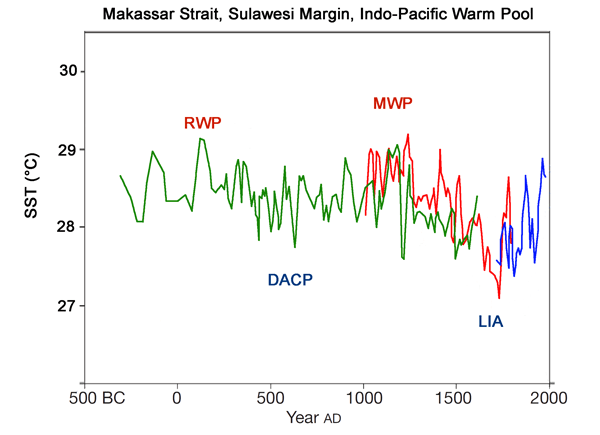Reference
Oppo, D.W., Rosenthal, Y. and Linsley, B.K. 2009. 2,000-year-long temperature and hydrology reconstructions from the Indo-Pacific warm pool. Nature 460: 1113-1116.Description
Oppo et al. derived a continuous sea surface temperature (SST) reconstruction from the Indo-Pacific Warm Pool (IPWP), which they describe as “the largest reservoir of warm surface water on the earth and the main source of heat for the global atmosphere.” This history — which was based on δ18O and Mg/Ca data obtained from samples of the planktonic foraminifera Globigerinoides ruber found in two gravity cores, a nearby multi-core (all at 3°53’S, 119°27’E), and a piston core (at 5°12’S, 117°29’E) that were recovered from the Makassar Strait on the Sulawesi margin — spans the past two millennia and, as they describe it, “overlaps the instrumental record, enabling both a direct comparison of proxy data to the instrumental record and an evaluation of past changes in the context of twentieth century trends.” Reconstructed SSTs were, in their words, “warmest from AD 1000 to AD 1250 and during short periods of first millennium.” From the authors’ Figure 2b, adapted below, we calculate that the Medieval Warm Period was about 0.4°C warmer than the Current Warm Period.

http://www.co2science.org/data/mwp/studies/l1_makassarstrait.php






Er moet een keuze gemaakt worden: accepteren we proxy data wel of niet?
Wie is "we" in dit verband? Natuurlijk kan de wetenschap niet zonder proxy data. Het gaat erom dat je er (statistisch) verantwoord mee omgaat. Nu Michael Mann en het "Team" hebben laten zien dat bedrog en zwendel alles van proxies te maken valt, wil het niet zeggen dat niemand meer proxies mag gebruiken. Dat is echt het kind met het badwater.
En al die andere proxies dan – gemaakt door andere teams, niet hét Team (de grote onzichtbare vijand die alles beheerst) – die ook een hockeystick laten zien?
Of is het zo simpel:
proxy die hockeystick laat zien -> niet statistisch verantwoord, ergo bedrog en zwendel
proxy laat ergens op de aardbol in een bepaalde periode een warmere periode zien dan nu -> goede wetenschap, AGW weerlegd
Die indruk krijg ik hier namelijk wel. En op een site als CO2science al helemaal.
Die indruk krijg ik niet. Wel als je alleen bepaalde blogs bekijkt, dan heeft u gelijk. Wat uit de discussie over de hockeysticktheorie en de beruchte 'hide the decline' wel duidelijk is geworden – maar die conclusie hebben Mann, Briffa e.a. nog niet echt getrokken – is dat boomringen als proxy voor temperatuurreconstructie onbruikbaar zijn.
Het selectief gebruik maken van die boomringen als proxy komt m.i. de argumenten van de klimatologen die de WMP pogen weg te poetsen, niet ten goede.
Maar u heeft gelijk dat er andere proxies zijn gebruikt waar hockeysticks uit te voorschijn zijn gekomen, zoals er ook reconstructies zijn die de WMP opeens weer wel vertonen.
Probleem met al die reconstructies is natuurlijk dat ze allemaal lokaal zijn en er te weinig zijn om een globaal beeld te krijgen. Globaal in de betekenis van wereldwijd. (Wat is het Nederlands toch een lastige dubbelzinnige taal in deze context!)
Tja, er zijn waarschijnlijk weer 10 andere studies die laten zien dat dit niet zo is, gebaseerd op andere proxies. Proxy studies zijn, gezien de ver uiteenlopende resultaten, gewoon nogal onzeker. De drang om te laten zien dat de huidige temperaturen zg. "unprecedented" zijn is een beetje geforceerd (ik twijfel er ook aan dat dat zo is, maar ook nogal aan het feit hoeveel het afdoet aan AGW, het verzwakt het observationele bewijs hoogstens iets, maar de (gedetailleerde) interpretatie van onze beperkte en korte meetreeksen is sowieso nogal moeilijk), het lijkt mij handiger om beter te kijken naar de onderliggende fysische processen. Als AGW zo'n groot effect heeft als de meeste klimaatwetenschappers beweren, dan zal het observationeel bewijs in de toekomst waarschijnlijk veel eenduidiger worden.
Helemaal eens met je standpunt: er wordt te veel waarde gehecht aan de gem. temp in het verleden. Ik denk echter niet dat je 10 andere studies zult vinden die in hetzelfde gebied zijn uitgevoerd; onderdeel van de hele discussie over de MWP is juist dat er weinig bewijs voor (of tegen) is op het zuidelijk halfrond.
Sterker nog: er wordt te veel waarde gehecht aan de gemiddelde temperatuur als fenomeen.
De gemiddelde waarde van temperatuurmetingen is geen fenomeen, het is slechts een rekenkundige uitkomst en beschrijft geen fysisch proces.
Uit de samenvatting op Nature.com http://www.nature.com/nature/journal/v460/n7259/f…
"Our record from the Makassar Strait, Indonesia, exhibits trends that are similar to a recent Northern Hemisphere temperature reconstruction2. Reconstructed SST was, however, within error of modern values from about ad 1000 to ad 1250, towards the end of the Medieval Warm Period. SSTs during the Little Ice Age (approximately ad 1550–1850) were variable, and approx 0.5 to 1 °C colder than modern values during the coldest intervals."
De '0,4 graden warmer' staat niet in het abstract genoemd, integendeel: de auteurs zeggen in de abstract dat de SST tijdens MWP 'within error' ligt van de SST nu. Begrijp ik het verkeerd of probeert 'CO2 science' conclusies aan het rapport te verbinden die de schrijvers zelf niet willen trekken?
Goed gevonden! Ik heb Marcel gevraagd het hele artikel te downloaden. Hij heeft een abonnement. En inderdaad: de 0.4 graden is nergens te vinden. MWP even warm als nu blijft niettemin een interessant gegeven. Ik heb de titel aangepast.
Hajo en Marcel, bedankt dat jullie er even in zijn gedoken!
Wat is overigens de nieuwswaarde van een Nature-artikel dat al bijna een jaar geleden (27 August 2009) is verschenen?
Sowieso doet deze studie alleen maar uitspraken over een enkele regio. Je kunt dus geen conclusies trekken over 'de tropische oceaan" in het algemeen. Ik lees her en der suggesties dat de centrale en oostelijke pacific juist weer koeler waren…
CO2Science is trouwens lekker aan het verdraaien:
Oppo et al: "the tropical Indo-Pacific warm pool (IPWB) represents a major heat reservoir that both influences global atmospheric circulation and responds to remote northern high-latitude forcings"
en daar maakt CO2Science dan van: "the Indo-Pacific Warm Pool (IPWP), which they describe as “the largest reservoir of warm surface water on the earth and the main source of heat for the global atmosphere.”
CO2science-gate!